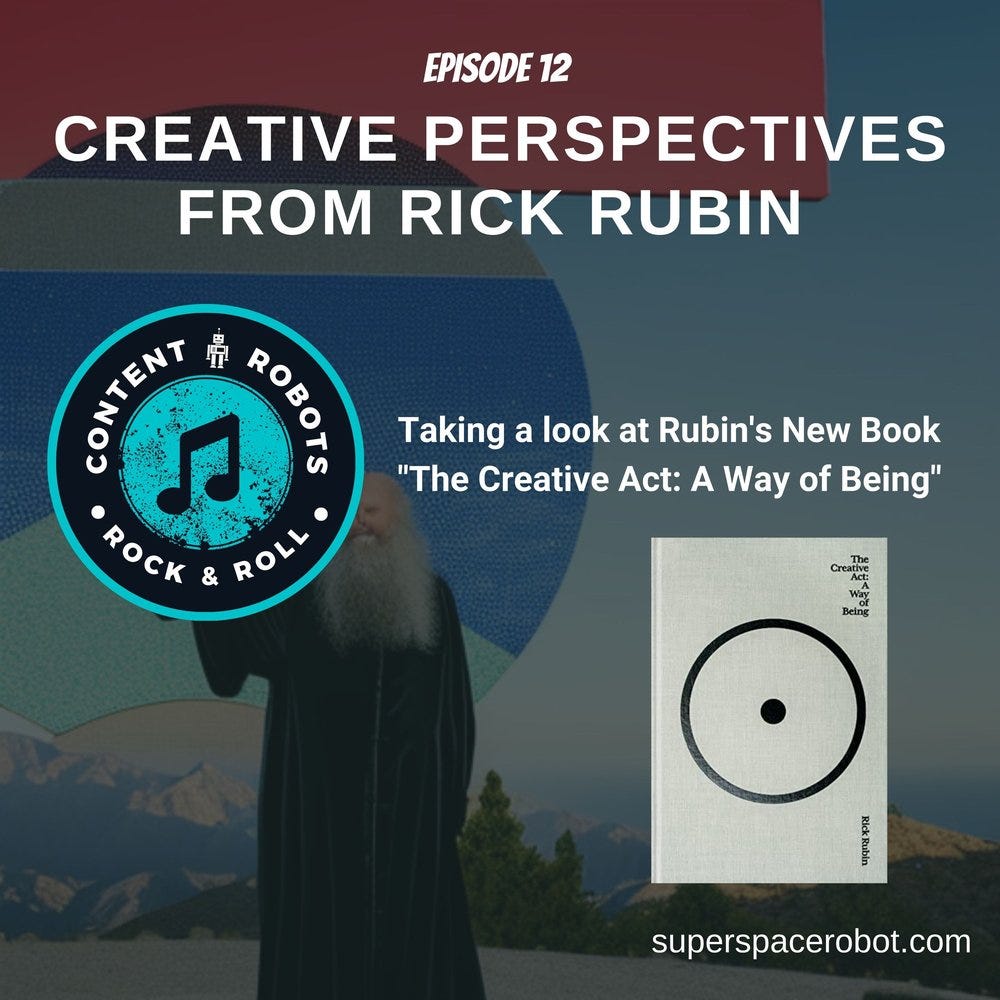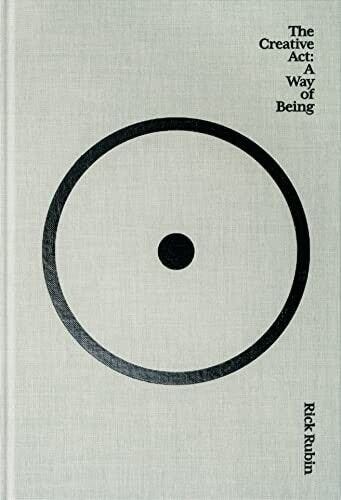Podcast Episode Details
Listen to the podcast to find out:
How to use the creative process to tell better stories and make better content that will set you apart from artificial intelligence (AI).
How the mind filters and distills the information that you receive about the world in order to inspire new creations.
Overall thoughts on Rick Rubin’s new book on creativity.
Book Report: “The Creative Act: A Way of Being” by Rick Rubin
Today on the podcast we are taking a look ata new book entitled The Creative Act: A Way of Being, written by famed rock and hip hop producer Rick Rubin. If you don't know Rubin, you probably know some of the music he's produced. This includes artists like Run-D.M.C., LL Cool J, The Beastie Boys, Public Enemy, Slayer, Danzig, Tom Petty, Johnny Cash, Audioslave, Metallica, Black Sabbath, Eminem, and so many more.
Since this is a podcast about creativity in the era of AI-generated content, I figured that — for fun — I'd start by having a robot generate my introduction to the book.
A ChatGPT-written Book Summary
Not wanting to spend too much time on that part, I put the following prompt into Chat-GPT:
Write a whimsical summary of the book The Creative Act: A Way of Being by Rick Rubin
In hindsight, the word whimsical might have been the wrong choice. You’ll see why in a moment. Here’s the description:
Once upon a time, in a magical kingdom called Hollywood, there lived a wise and mystical wizard named Rick Rubin. He was known throughout the land as the master of music, the king of creativity, and the guru of good vibes.
One day, he decided to share his secrets with the world, and he wrote a book called "The Creative Act: A Way of Being." In this book, he explained that creativity wasn't just a skill or a talent, but a way of life. He said that to be truly creative, you must be open to the world around you, and let your imagination run wild.
He told tales of his adventures with some of the greatest artists of our time, from Johnny Cash to Jay-Z, and how they each found their own unique ways to tap into their creative energy. He shared his own methods for staying inspired, such as meditating, taking long walks, and playing with his dogs.
But most of all, he encouraged his readers to embrace their own inner magic and to let their creativity soar. He reminded them that anything is possible if you believe in yourself and follow your heart.
And so, the people of Hollywood and beyond read his book and were inspired to create, to dream, and to live their lives as if every day was a new adventure. And they all lived happily ever after, with a little help from the wisdom of the wizard Rick Rubin.
Despite the...whimsy — Chat-GPT got that kind of right. I didn't give it much input so I can’t really criticize the strange, yet mostly accurate path it went down.
To be safe, I’ll take the wheel from here.
Structure of The Creative Act
The Creative Act is a book that gives us an inside look at how Rubin finds creativity, both within himself and within the artists he works with. It's a thoughtful book that's come at the perfect time for content creators, marketers, brands, and anyone else that's tasked with creating unique, differentiating content.
The book is organized into many short chapters on different topics with titles like "Look Inward," "Self-Doubt," "Distraction," "Collaboration," "Make It Up," "Breaking the Sameness," and many more. That makes it easy to dive into a few chapters at a time very quickly and internalize the lessons Rubin tries to impart.
The Vessel and the Filter
Today I want to highlight one particular chapter of Rubin's book that I thought was useful to our current discussion: "The Vessel and The Filter." The premise of this chapter is that we all have a container within ourselves — a vessel — that we use to collect data from dreams, thoughts, and life experiences.
Sometimes the data that enters the vessel can be the same, meaning that people might have shared experiences or similar thoughts. However, this data is filtered differently by each of us. Sometimes things don't get through at all. We can't take everything in, and our senses aren't always able to perceive all of the information that surrounds us.
The way we filter information eventually becomes our beliefs and stories — a unique and particular point of view about the world we live in.
Rubin tells us to take in as much of the data around us as possible. Then we can create new things by selecting and distilling the elements in the data that seem useful and relevant. From that distillation, we can then re-present them as something new.
To complete this process, it's important to share our creations. When we share what we create, our work can then become source material for others to build on and create on.
I think this is a powerful and important way to look at the process of creation — no matter what you might be creating.
We all take in the same, information about the world around us, but our minds filter, and select important information differently. We draw different conclusions about what's important and what's not.
We learn from the information shared by others and incorporate that into our own points of view.
This process is why inspiration for content can come from so many places. It's why great ideas and stories can build on each other — growing and evolving into new and better things.
Our Filters are Inconsistent
It isn't always a positive, though. It could be why people have such different viewpoints, beliefs, and interpretations about the same information. This happens particularly in areas like politics and religion — or with science and medical-related topics as we have seen in recent years.
It's also, incidentally, why AI can seem so good at presenting information in ways that astound people who work with it. AI mimics human thought. It has a virtual version of that filter and vessel that Rubin talks about.
The Role of AI
AI can take in extraordinary amounts of information, and then distill it into content using its human-created algorithms. Its programming mimics the human experience because it was taught to do so.
But it can be lacking in areas like context. If I had told you to write me a whimsical introduction to the book, The Creative Act: A Way of Being by Rick Rubin that I could use in my podcast, you probably would have understood that I wasn't looking for a whimsical fairy tale introduction, presenting Rick Rubin as some sort of benevolent wizard. Without additional information beyond what I gave it, the AI wasn't able to quite pick that up.
Reading The Room
Taking this a step further, have you ever said or posted something that didn't go over well, and someone told you to "read the room?"
AI isn't able to "read the room," without being specifically told to do so. It's not surprising, since so many humans also lack this talent.
That's all fine. We can give it context clues to help it along. AI will undoubtedly get better at this over time too. For now, though, the best vessel and filter for internalizing, distilling, and sharing information is still the human mind.
If You Create Stuff Online, You Should Own This Book
I'll talk more about my favorite moments from The Creative Act periodically throughout the year. For now, I encourage everyone who makes stuff own the internet — or not on the internet — everyone who makes anything (which is everyone) — to get Rubin's book.
If you get the audiobook, I recommend grabbing the physical copy, too — it's a nice looking hardcover book that, if nothing else, will be impressive in the background of your next Zoom call. It's a short, quick read that you can refer to over and over.
RRR: Rick Rubin Recommendations
Rick Rubin has had an illustrious career spanning 4 decades. He started Def Jam Records and, along with Russel Simmons, helped to usher in the hip hop explosion in the 1980s. To learn more about Rick Rubin, I recommend starting with the music he’s helped to make. Here are three albums he has produced that I recommend checking out.
Raising Hell from Run-DMC (1986)
This is one of the records that you might say put Rubin on the map: Raising Hell from Run-D.M.C. If you're of a certain GenX vintage like I am, you'll know most of this record.
Reign In Blood from Slayer (1986)
For something completely different, how about the third album from one of thrash metal's "Big 4": Slayer's 1986 release Reign in Blood? This is my personal favorite of Slayer's albums. Listen at your own risk. It's an experience.
American II: Unchained from Johnny Cash (1996)
The final recommendation is the second of the five albums Rubin made with country music legend Johnny Cash near the end of his life. All five of the "American Recordings" albums are worth listening to, but "American 2" is my favorite. It features some great music, including a cover of Soundgarden's Rusty Cage, and Tom Petty's Southern Accents.
Listen to those three albums in a row to get an idea of just how important and influential Rubin has been in bringing the best out of some very different kinds of musical artists. He's been behind some of the greatest music of the rock & roll era.
What creativity can his book, The Creative Act: A Way of Being, bring out in you?








Creative Perspectives from Rick Rubin